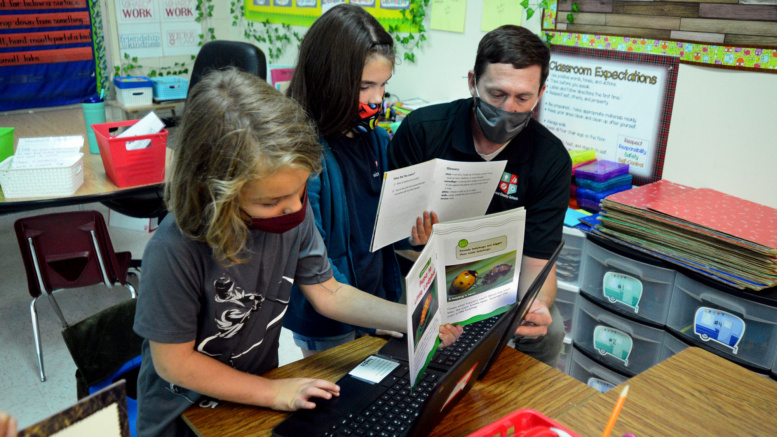Classrooms Increasing Their Digital Learning
BY MARY KATE MURPHY
SLI Reporter
If the COVID-19 pandemic has had a silver lining in elementary school classrooms, it’s the metallic sheen of the iPads and Chromebooks in the hands of every Moore County Schools student.
That’s every student, down to the last kindergartener. It’s a goal district administrators hadn’t dared to set even two years ago. Since 2016, the school board has routinely asked for funding to provide individual computers for just third grade and up, but to little avail.
The nearly unprecedented influx of state and federal funding to public schools over the last 18 months changed that.
For a full two months at the end of the spring 2020 semester, the only way for teachers to reach their students was virtually. Suddenly every student needed a way to get online, whether they were old enough for state end-of-year testing or not.
When in-person learning resumed in the fall of 2020, it was only part-time. Students were still learning from home three days a week. By then, Moore County Schools had cobbled together enough machines for every student in second grade and up to have a basic Chromebook computer. Kindergarteners and first grade students were issued iPads.
The district achieved that through a combination of state and federal COVID-19 relief funding — and a generous amount of duct tape. But it’s unlikely that the district will be able to sustain all the new technology after that funding runs out in the next few years.
“The issue of one-to-one has really not been a heavy issue for us until we had the ESSER funds,” Superintendent Bob Grimesey said at a board meeting last month.
Earlier this year, the school board signed off on spending $1.3 million in funding to the district from the American Rescue Plan to buy 3,800 new Chromebooks over two school years. Since 2013 Moore County Schools has funded Chromebooks for middle and high school students on a four-year replacement cycle.
But it’s also unclear — at least in the case of kindergarten, first, and even second grade — that the school board will have much interest in preserving the availability of devices for every student.
“It is not that we don’t want K-1 to have access and knowledge in the digital age,” said board member Robert Levy. “But in those early years they need to know how to read books, and they need to know how to write and how to do both fine motor skills and gross motor skills and things like that.”
Tools to Assess Learning
Technology use in schools is a wave of change that individual school districts would be hard pressed to electively sit out. For one thing, North Carolina has shifted from funding traditional textbooks to digital content subscriptions. For another, it’s part of schools’ mission to help students become “digital citizens” who can work productively online as well as play.
To what extent devices are adopted has always varied from school to school and teacher to teacher. Some elementary school principals were using discretionary funds for their schools to provide one-to-one devices even before 2020.
Where that hadn’t happened, many teachers still found ways to incorporate technology into their classes as a learning “station” for students to rotate through.
At Southern Pines Elementary, Nicki Bauer doesn’t ask her kindergarten students to sit in the same chair for more than 10 minutes or so, let alone focus on an iPad uninterrupted for that long.
“Last year, I was a virtual teacher, so individual iPad activities were one of the ways that I could see if the students were understanding what I was teaching,” Bauer said. “This year we are currently one-to-one with devices but this may not always be the case, so I am taking full advantage of it.”
Before the pandemic, Bauer had about 10 iPads available for her class, or roughly one for every two students. So her students didn’t typically use devices daily.
Virtual learning in 2020 forced a paradigm shift for many educators. Even now that most students are back in class daily, teachers have gotten used to technology-assisted instruction.
It’s not that the iPads and Chromebooks do the teaching, or that somehow teachers have less work to do when their students are “plugged in.” But there’s only one Nicki Bauer, plus her classroom assistant, for her 20 kindergarteners.
Individual devices give students a chance to work at their own level, whether they’re easily mastering concepts ahead of schedule or struggling with them. Interactive assignments that don’t feel like tests give real-time feedback on how well they’re doing.
That data is then stored for teachers to review later, complete with feedback about each student and which specific concepts might need reinforcing.
This year, Bauer’s class spends a total of 30 to 40 minutes on iPads between five-to-10-minute activity blocks interspersed throughout the day. Each of those blocks is devoted to activities on a different application.
Students might spend a few minutes engaged in a read-along activity using Epic Books, allowing each child to work at their own proficiency level and make progress at their own pace. Then they all move to a mat at the front of the classroom while Bauer leads a brief lesson. After that, another activity using an iPad application like Seesaw or Boom Cards reinforces the topic of the day.
At that point, Bauer might pull a small group aside to her table for more individualized attention.
“I find when the kids are working individually on something on their iPads after having been taught it is a great way to assess learning. If a student struggles with the accompanying Seesaw or Boom assignment it helps me to better tailor my instruction to meet that student’s needs,” she said.
“Individual devices with specifically assigned items are a quick and easy way to check for understanding. I also find that engagement in iPad activities is more consistent than with the traditional centers.”
Learning New Techniques
Teachers are also thinking outside the box when it comes to making technology an age-appropriate, dynamic learning medium. In Moore County Schools, they have help from staff members known as “digital integration facilitators,” all former teachers who now help classroom teachers put technology to good use. The district has a dozen or so who each split their time between multiple schools.
Johnna Prevatte’s second-grade class at Cameron Elementary recently learned about text features and their functions: index, glossary, photo captions, diagrams, etc. With the help of digital integration facilitator Clint Rogers, she assigned her students a scavenger hunt of sorts among several dozen reference books.
Their task: identify various text features in those physical books, then use Chromebooks to photograph them and organize the photos in a neat labeled chart.
Such activities offer a multi-step process to help solidify those concepts, but they also offer students several ways of demonstrating their grasp of the content beyond just getting questions right on paper.
“Students who have learning difficulties have multiple ways to show their understanding using the applications and resources to which we have access,” said Prevatte. “A student who has difficulty reading and writing can record himself or herself retelling a story using the video or voice recording option on Seesaw. I can then still check the students’ understanding of the content although they have difficulties providing written responses.”
The sight of 20 or so seven-year-olds focused on Chromebooks might not look like the traditional idea of “second grade.” But Prevatte said that technology allows teachers to expand on what they were already doing in ways they couldn’t with physical activities.
“With the changing times and technology becoming more a part of everyone’s daily lives, using it consistently in the classroom is one huge way to make sure our students are ready for their futures,” she said.
But Worth the Cost?
There’s still the question of cost, and whether administrators and school board members believe digital learning is worthwhile from kindergarten up.
Last month the school board unanimously approved the purchase of 450 new iPads for kindergarten and first-grade classrooms at a cost of $132,000 from the district’s regular technology funding. Those will replace devices dated from 2015: the ones held together with duct tape and running obsolete software.
Before that vote came questions about what the district has already done for the youngest grades — smaller class sizes, teacher assistants — and if there’s data showing that one-to-one devices effectively get students reading on grade level.
“It wasn’t that many years ago that we didn’t have electronic devices, so I would be interested to see the evidence that these devices are improving the reading and arithmetic of our kindergarteners and first-graders and actually all of our elementary school students,” said David Hensley. “I haven’t seen any evidence that it increases our scores. Do we have that information?”
Costs will likely force a discussion of one-to-one devices in the younger elementary grades as more students return to the classroom from Moore County Schools’ virtual academy in the next year or two. The schools will have to find money for another 550 iPads by the fall of 2022 to keep kindergarten and first grade even at one iPad for every two students.
If the school board backs off on funding devices for the younger grades around Moore County Schools, some schools will continue on their own.
Last month, board members discussed technology with some principals during their regular school improvement plan presentations.
West End Elementary Principal Shaun Krencicki was asked if one device for every two students would be an acceptable standard. He didn’t equivocate in his response.
“If you’re asking, one-to-one. That’s what it should be,” he said.
“We’ll make it work because we’ll use funds that we have and probably go one-to-one anyway. That’s just the truth. We’ll take whatever you can give us and then we’ll find the support.”
Contact Mary Kate Murphy at (910) 693-2479 or mkmurphy@thepilot.com.








